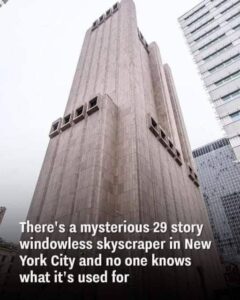In Lower Manhattan, there is a unique 29-story skyscraper called Titanpointe at 33 Thomas Street. It doesn’t have any windows and has intrigued New Yorkers for a long time.
In 1974, a building was built to withstand atomic blasts. It was originally meant to store important telecommunications equipment. The architectural firm John Carl Warnecke & Associates designed it as a secure communication hub, protected from nuclear dangers.

This massive building, a tall tower made of concrete and granite reaching 550 feet high in the New York City skyline, stands out from the rest. Unlike the nearby residential and office buildings, it lacks any windows and stays dark. During the night, it gives off a spooky vibe, and during the day, it creates a large shadow with its square vents making a soft humming noise, sometimes overshadowed by the busy city noises.
33 Thomas Street, known as the “Long Lines Building,” has fascinated New Yorkers for many years as a peculiar and famous skyscraper. However, the real function of this mysterious building has mostly been kept hidden and secretive.
The Hidden Truth of 33 Thomas Street.
33 Thomas Street hides a mysterious secret beneath its mysterious appearance. This structure seems to have a greater purpose than being a mere telecommunications center. Information gathered from documents acquired by Edward Snowden, a whistleblower from the NSA, as well as architectural blueprints and interviews with former AT&T workers, indicate that 33 Thomas Street operated as a surveillance location for the NSA, known as Titanpointe.
The NSA is suspected of more than just speculation. Within the building, there is a significant international gateway switch that directs phone calls between the U.S. and various countries globally. It is thought that the NSA has intercepted these calls from a secure facility inside the AT&T building. This secret surveillance program has focused on not just international organizations such as the United Nations, the International Monetary Fund, and the World Bank but also several countries, even those allied with the U.S.
AT&T has worked with the NSA on surveillance, but there is limited information on the exact involvement of buildings like 33 Thomas Street in secret programs. The Snowden files offer new information on how NSA equipment is used in AT&T’s network in NYC, showing how the agency collects data from the company’s systems.
The NSA being in this famous skyscraper makes people wonder about surveillance limits today. Elizabeth Goitein, co-director of the liberty and national security program at the Brennan Center for Justice, highlights this. “This is yet more proof that our communications service providers have become, whether willingly or unwillingly, an arm of the surveillance state.”The close connection between the NSA and domestic communication systems questions the idea that surveillance is limited to non-American targets.
AT&T, Privacy, and Legal Supervision.
AT&T’s extensive partnership with the NSA has been widely recorded. Although AT&T has had a longstanding connection with the government, it remains uncertain if the NSA utilized AT&T’s facilities or resources at 33 Thomas Street. This lack of clarity gives rise to inquiries regarding the level of government surveillance conducted within the building.
In August 2015, The New York Times and ProPublica revealed that AT&T had a long history of working with the NSA and was praised for being very cooperative. However, there is no definite proof from Mr. Snowden’s documents or the recent reports that the NSA was actually using AT&T’s facilities. AT&T Inc. owns most of the space at 33 Thomas, but Verizon also owns a portion of it.
The NSA’s role in monitoring at 33 Thomas Street brings up important legal and moral concerns. The building could symbolize the fine line between privacy and security in our digital age, as well as the difficulties of maintaining proper supervision in a time of sophisticated technology and government surveillance.
To sum up, 33 Thomas Street is a famous and mysterious skyscraper in New York City, with a rich history in telecommunications and a connection to modern surveillance. The full extent of its role in government spying may never be fully known, but it serves as a reminder of the complex relationship between privacy and security in today’s digital age.





